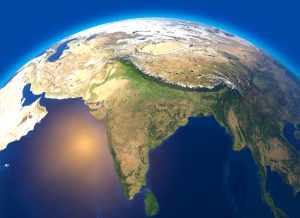According to the United States’ “China’s Military Power Report 2022,” China’s People’s Liberation Army Navy (PLAN) is “numerically” the largest navy in the world. The report also highlights that the PLA support base in Djibouti is going to play a crucial role in providing China the capacity to “project and sustain military power at a greater distance.”
The PLA has constructed a 300-meter-long berthing area, which is now ready to accommodate larger vessels like aircraft carriers, submarines, and amphibious vessels in the future. Experts also point out China may build additional facilities like drydock and repair facilities for both surface ships and submarines. Since it officially opened in 2017, the support base has been undergoing construction of new piers and is also suspected to have an underground electronic and cybersecurity facility. The support base is actively engaged in military exercises and outreach activities to demonstrate its presence in the region.
Even though China presented the Djibouti base to the international community as a “logistic facility” or “support base,” the latest development activity shows it has truly become a complete naval base. As China seeks to expand its presence in the Indian Ocean region (IOR) through economic and commercial activity, the operation of new piers in Djibouti – and as a result, the increasing presence of Chinese submarines, survey and hydrographic ships close to Indian coasts – calls for greater security concern in India.
The PLAN presence in the Indian Ocean has been growing steadily since 2009. When piracy and hijacking ships for ransoms in the Gulf of Aden were disturbing global energy and trade routes, China joined the international effort to police the regional waters. Even today, a major justification for the PLAN presence is to ensure the security of their commercial engagements and maritime trade. Since 2013, Chinese submarines have been in the Indian Ocean, and they claim to be deployed for anti-piracy duties.
Chinese submarines use the Malacca, Lombok, or Sunda Straits to reach the Indian Ocean. The Sunda Straits are very shallow, with a mean depth of 50 meters. Sandbanks, the presence of oil platforms in the Sunda shelf, and the active presence of fishing vessels render it difficult to navigate in these waters. The Lombok Strait is deep enough for submarines to proceed in the normal mode of navigation. In the case of the Malacca Strait, to ensure navigation safety Chinese submarines have to navigate on the surface. The submarines are often accompanied by submarine-tender ships, a giveaway for the presence of the Chinese submarine.
The deployment of submarines along with PLAN’s survey and hydrographic ships in the Indian Ocean has become a regular feature since 2017. According to Indian news reports, in 2017, the PLAN’s top naval survey ship – the Type 636A hydrographic survey ship Haiyang Class 22 – was surveying the waters of the Indian Ocean, in all probability charting for better submarine operations.
In 2018, the PLAN’s modern Type 625C Shiyan 3 Oceanographic Survey Ship surveyed the Makran Trench in the Persian Gulf as part of its maritime exercise with the Pakistan Navy. In the same year, the Xiang Yang Hong 10 was deployed in the Indian Ocean to survey the China Ocean Mineral Resources Research and Development Association (COMRA) contract zone in the Southwest Indian Ocean.
Since 2019, Chinese survey ships like the Xiang Yang Hong 03 have surveyed the deep waters of the Bay of Bengal, the Arabian Sea, and the water west of Indonesia, considered an important area of submarine operations for both India and Australia. China has also deployed a fleet of underwater drones in the Indian Ocean to study the aquatic environment, hydrography, bathymetric conditions, sea-water temperature and salinity etc. which can be used for military applications to get better sonar performance of Chinese submarines as well as to improve the detection capability of Chinese anti-submarine warfare (ASW) assets in these waters.
The use of a sea-glider by China grabbed global media attention when one of the Haiyi gliders was captured by an Indonesian fisherman off Selayar Island in South Sulawesi province in December 2019. China is also focusing on building new generations of underwater gliders and Argo floats for specific military purposes. Notably, an underwater acoustic glider, which is currently under development, can be a real game changer for China in detecting and tracking submarines in the Indian Ocean.
The increasing presence of Chinese state-run hydrographic ships, and survey vessels will facilitate future deployment of Chinese SSBNs and SSNs in the Indian Ocean. Unlike the West Pacific, which is crawling with U.S. Navy and Japan Maritime Self-Defense Force submarines and ASW ships monitoring PLAN submarine movements, the Indian Ocean is relatively safe for Chinese submarines to operate. However, passing choke points without being detected is going to remain a major challenge for Chinese submarines entering the Indian Ocean. The Djibouti support base can help to overcome this fundamental problem, and the deployment of submarines to this base looks like the next possible move by Beijing to expand its influence in the region.
China’s naval base in Djibouti and the growing presence of PLAN ships, submarines and research vessels in the Indian Ocean is a call for greater concern in New Delhi. It not only challenges India’s sphere of influence in the region but also raises the risk of security threats when Chinese vessels operate close to India’s Exclusive Economic Zone. In 2022, India had to postpone missile tests due to the presence of Chinese surveillance vessels Yuan Wang 6 and Yuan Wang 5 in the Indian Ocean. Moreover, India is also suspicious of Chinese deep-sea fishing vessels spying on Indian missile launch facilities, naval bases, and vessel movement in the Bay of Bengal and Arabian Sea.
India needs to strengthen its underwater domain capability and requires a fresh rethink on the concept of undersea warfare to deal with the emerging underwater threat from China in the Indian Ocean.

































